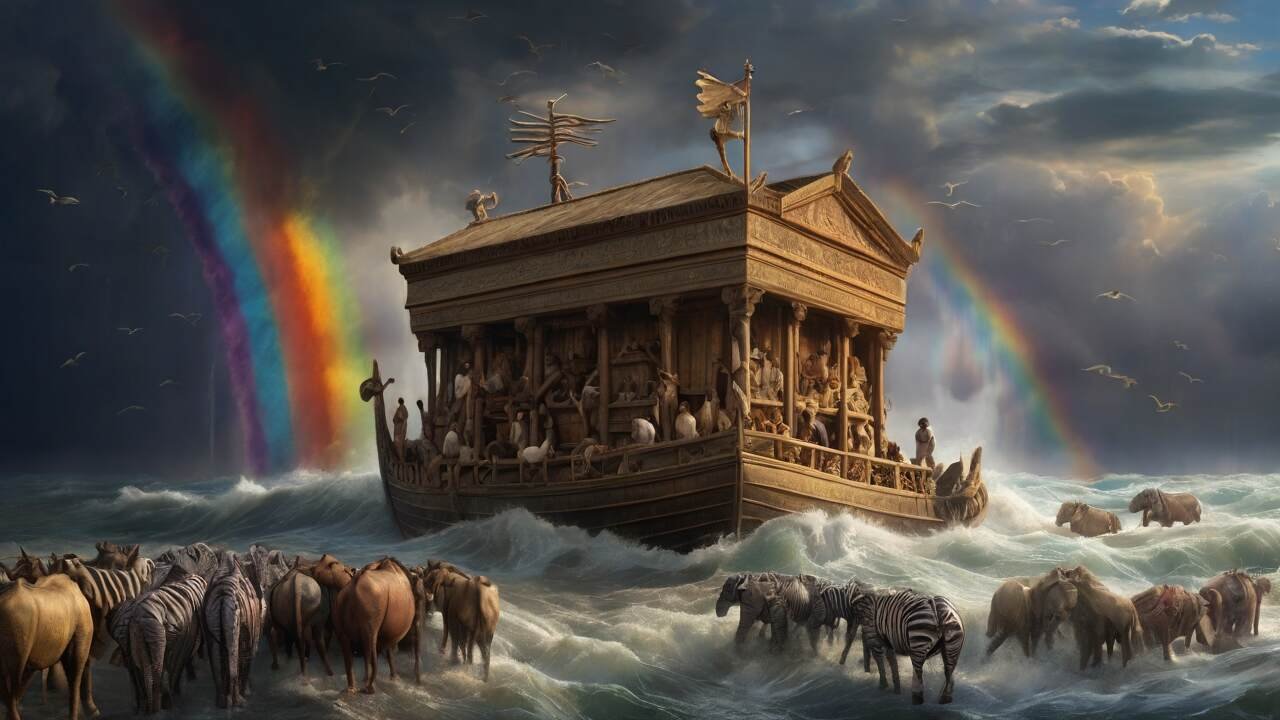The biblical book of Exodus recounts the captivating story of the Israelites’ departure from Egypt, as narrated in the revered King James Version (KJV) of the Bible. This pivotal narrative describes how the Israelites, long enslaved by the Egyptians, were ultimately led out of their bondage by the courageous figure of Moses. The Exodus marks a transformative moment in the history of the biblical Israelites, as they embark on a journey from the shackles of slavery towards the promise of freedom and the Promised Land.
Key Takeaways
- The book of Exodus recounts the Israelites’ departure from Egypt as told in the KJV Bible
- The Israelites were enslaved by the Egyptians before being led out by Moses
- The Exodus represents a pivotal moment in Israelite history, transitioning from slavery to freedom
- The narrative follows the Israelites’ journey towards the Promised Land
- The KJV Bible provides a revered and authoritative account of this biblical story
Describe the Exodus of the Israelites from Egypt as narrated in the KJV Bible
The Israelites, God’s chosen people, found themselves in a state of oppression and slavery in the land of Egypt. According to the King James Version (KJV) of the Bible, the Pharaoh of Egypt had subjected the Israelites to rigorous labor, forcing them to toil in mortar, brick, and field work. The Israelite people were made to serve the Egyptians with great rigor, as the Pharaoh sought to maintain his control over them.
During this time of enslavement, the Pharaoh issued a decree that all newborn Israelite boys were to be killed. However, the Hebrew midwives, fearing God, disobeyed the Pharaoh’s orders and saved the children. It was in this context that Moses was born, hidden by his mother to protect him from the Pharaoh’s wrath.
The young Moses was eventually found by Pharaoh’s daughter, who took pity on him and raised him as her own son in the royal household. Despite his privileged upbringing, Moses later fled to the land of Midian after killing an Egyptian, setting the stage for his divine encounter with God and his eventual call to deliver the Israelites from their bondage.
“And the children of Israel sighed by reason of the bondage, and they cried, and their cry came up unto God by reason of the bondage.” (Exodus 2:23)
The Israelites’ enslavement in Egypt and the birth of Moses, as narrated in the KJV Bible, set the stage for the dramatic events that would unfold in the Exodus, leading to the Israelites’ deliverance from the oppressive rule of the Pharaoh.
Moses’ Encounter with God and the Call to Deliver Israel
In a dramatic turn of events, as Moses tended his father-in-law’s flock in the land of Midian, he encountered a remarkable sight – a burning bush that was not consumed by the flames. This supernatural occurrence set the stage for a pivotal moment in the life of Moses and the Israelites’ journey to deliverance.
As Moses approached the burning bush, he heard the voice of God calling out to him. The Almighty revealed Himself as the God of Abraham, Isaac, and Jacob, and declared that He had seen the affliction of the Israelites in Egypt and had come to deliver them from the oppression of Pharaoh. God then commissioned Moses to go before Pharaoh and demand the release of the Israelites, promising to be with him every step of the way.
Initially, Moses was hesitant, expressing doubts about his ability to lead the Israelites out of Egypt. However, God reassured him, saying, “Certainly I will be with you,” and provided him with the necessary tools and authority to carry out this monumental task.
“Then Moses answered and said, ‘But, behold, they will not believe me, nor hearken unto my voice: for they will say, The Lord hath not appeared unto thee.’ And the Lord said unto him, ‘What is that in thine hand?’ And he said, ‘A rod.’ And he said, ‘Cast it on the ground.’ And he cast it on the ground, and it became a serpent; and Moses fled from before it. And the Lord said unto Moses, ‘Put forth thine hand, and take it by the tail.’ And he put forth his hand, and caught it, and it became a rod in his hand.” (Exodus 4:1-4)
Ultimately, Moses accepted God’s call to lead the Israelites out of Egypt and into the promised land, setting the stage for the dramatic events that would unfold in the Exodus narrative.
The Ten Plagues and the Passover
In the captivating narrative of the Exodus, as told in the King James Version (KJV) of the Bible, God unleashed a series of ten devastating plagues upon the land of Egypt to convince Pharaoh to let the Israelites go. These Plagues were a powerful display of divine might, testing the resolve of the Egyptian ruler and paving the way for the Israelites’ liberation from their long-standing bondage.
The Plagues and Pharaoh’s Hardened Heart
The Plagues began with the Nile turning to blood, followed by a swarm of frogs, gnats, flies, the death of livestock, boils, hail, locusts, darkness, and the ultimate plague – the death of the firstborn. Despite these relentless demonstrations of God’s power, Pharaoh’s heart remained stubbornly hardened, unwilling to heed the divine command to let the Israelites go.
- Nile turned to blood
- Swarm of frogs
- Gnats
- Flies
- Death of livestock
- Boils
- Hail
- Locusts
- Darkness
- Death of the firstborn
The Passover and the Exodus Begins
As the final plague, the death of the firstborn, approached, the Israelites were instructed to mark their doorposts with the blood of a lamb, a symbol that would prompt the Lord to “pass over” their homes, sparing their firstborn. This pivotal event, known as the Passover, ultimately shattered Pharaoh’s resolve, and he relented, allowing the Israelites to depart from Egypt. The Exodus had begun, with the Israelites miraculously crossing the Red Sea as the waters parted, leaving Pharaoh and his army behind.
“And it came to pass, that at midnight the Lord smote all the firstborn in the land of Egypt, from the firstborn of Pharaoh that sat on his throne unto the firstborn of the captive that was in the dungeon; and all the firstborn of cattle.” (Exodus 12:29)
The Exodus story, as recounted in the KJV Bible, stands as a pivotal moment in the history of the Israelites, where the power of God was displayed through the Ten Plagues and the miraculous Passover, ultimately leading to their liberation from the oppressive rule of Pharaoh.
The Wilderness Wanderings and the Giving of the Law
As the Israelites embarked on their journey through the wilderness, they faced a myriad of challenges. Hunger and thirst threatened to overwhelm them, but God provided for their sustenance in miraculous ways. The KJV Bible recounts how God rained down bread, known as manna, from heaven, and sent flocks of quails to nourish the Israelites during their wilderness wanderings.
The Israelites’ trek through the wilderness was not merely a physical journey; it was also a spiritual odyssey. At the sacred Mount Sinai, Moses ascended the mountain to commune with God, and the Israelites received the Ten Commandments and other divine laws that would shape their moral and social fabric. These teachings, etched in stone, would become the foundation of the Israelites’ relationship with their Creator and the guiding principles for their lives as a chosen people.
The Journey Through the Wilderness
The Israelites’ journey through the wilderness was marked by hardships and divine provisions. Faced with hunger and thirst, they cried out to God, who responded with miraculous sustenance. The Bible recounts how God rained down manna from heaven, a food so pure and nourishing that it was known as the “bread of angels.” Additionally, flocks of quails were sent to provide the Israelites with meat, ensuring their physical needs were met during their arduous trek.
The wilderness wanderings were not merely a test of endurance; they were a time of spiritual growth and reflection. The Israelites learned to trust in God’s provision and to keep the Sabbath holy, resting on the seventh day as a testament to their faith.
The Arrival at Mount Sinai
The culmination of the Israelites’ journey through the wilderness was their arrival at Mount Sinai, where God would bestow upon them the Ten Commandments and other laws that would shape their identity as a nation. Moses ascended the mountain, where he encountered the divine presence and received the sacred tablets that would become the cornerstone of Israelite society.
The Ten Commandments, etched in stone, served as a moral and ethical framework for the Israelites, guiding them in their relationship with God and with one another. These timeless principles, including the prohibition of idolatry, murder, and theft, would become the foundation of the Israelites’ faith and the basis for their covenant with their Creator.

The Israelites’ time in the wilderness was a transformative period, where they learned to rely on God’s providence and received the divine laws that would shape their identity as a chosen people. This sacred journey prepared them for the next chapter of their story – the conquest of the Promised Land.
The Promised Land in Sight
As the Israelites journeyed through the wilderness, their destination came into view – the Promised Land, a land “flowing with milk and honey” that God had sworn to give to their forefathers, Abraham, Isaac, and Jacob. This lush and fertile region, known as Canaan, was inhabited by various Canaanite tribes, including the Hittites, Amorites, Hivites, and Jebusites, whom the Israelites were commanded to drive out.
The book of Exodus sets the stage for the Israelites’ conquest and settlement of the Promised Land, as narrated in the subsequent books of the Old Testament. The Israelites, led by the mighty prophet Moses, were on the cusp of fulfilling God’s promise and claiming the land that had been rightfully theirs all along.
However, the road to the Promised Land was not without its challenges. The Canaanite tribes were a formidable presence, and the Israelites would have to rely on their faith, courage, and the guidance of their divine leader to overcome these obstacles and claim their rightful inheritance.
| Canaanite Tribes | Characteristics |
|---|---|
| Hittites | A powerful ancient Near Eastern civilization known for their military strength and advanced technology. |
| Amorites | A Semitic-speaking people who established kingdoms in Canaan and Mesopotamia during the Bronze Age. |
| Hivites | A Canaanite tribe known for their peaceful and diplomatic nature, often engaging in trade with neighboring civilizations. |
| Jebusites | The original inhabitants of Jerusalem, known for their strong fortifications and strategic location. |
As the Israelites stood on the threshold of the Promised Land, they were filled with a sense of anticipation and determination, ready to conquer and claim the land that God had set aside for them. The journey had been long and arduous, but the ultimate prize was now within their grasp.
“And I am come down to deliver them out of the hand of the Egyptians, and to bring them up out of that land unto a good land and a large, unto a land flowing with milk and honey; unto the place of the Canaanites, and the Hittites, and the Amorites, and the Perizzites, and the Hivites, and the Jebusites.” (Exodus 3:8)
Conclusion
The biblical account of the Exodus, as described in the King James Version of the Bible, offers a profound and inspiring narrative of the Israelites’ remarkable journey from slavery in Egypt to the borders of the Promised Land. This pivotal chapter in the history of God’s chosen people testifies to the power of faith, divine intervention, and unwavering leadership in the face of overwhelming adversity.
Throughout the Exodus story, we witness how the Almighty God, through the courageous efforts of Moses, liberated the Israelites from the oppression of Pharaoh and the Egyptians. The dramatic unfolding of the Ten Plagues, the miraculous Passover, and the Israelites’ miraculous passage through the Red Sea stand as powerful reminders of God’s sovereignty and His unwavering commitment to His people.
As the Israelites traversed the wilderness, the Exodus narrative further illuminates the divine guidance and provision that sustained them, ultimately leading them to the borders of the Promised Land. The establishing of the Mosaic Law at Mount Sinai and the Israelites’ preparation to enter the land God had promised their ancestors serve as a testament to the transformative power of this pivotal journey.
FAQ
What is the biblical account of the Exodus of the Israelites from Egypt?
The biblical book of Exodus in the King James Version (KJV) of the Bible recounts the story of the Israelites’ departure from Egypt. It describes how the Israelites, enslaved by the Egyptians, were led out of Egypt by Moses after a series of plagues inflicted upon the Egyptians. The Exodus marks a pivotal moment in the history of the Israelites, as they journey from slavery to freedom and towards the Promised Land.
How were the Israelites enslaved in Egypt?
According to the KJV Bible, the Israelites were enslaved in Egypt, forced to serve the Egyptians with rigor and made to labor in mortar, brick, and field work. Pharaoh ordered the Hebrew midwives to kill all newborn Israelite boys, but the midwives feared God and saved the children. Moses was born during this time and was hidden by his mother, before being found and adopted by Pharaoh’s daughter.
How did Moses encounter God and receive the call to deliver the Israelites?
While tending his father-in-law’s flock in Midian, Moses encountered God in the form of a burning bush. God revealed Himself as the God of Abraham, Isaac, and Jacob, and declared that He had seen the affliction of the Israelites in Egypt and had come to deliver them. God commissioned Moses to go to Pharaoh and demand the release of the Israelites, promising to be with him. Moses initially hesitated, but ultimately accepted the call to lead the Israelites out of Egypt.
What were the Ten Plagues and the Passover event that led to the Exodus?
According to the KJV Bible, God sent a series of ten plagues upon Egypt to convince Pharaoh to let the Israelites go. These plagues included the Nile turning to blood, a swarm of frogs, gnats, flies, the death of livestock, boils, hail, locusts, darkness, and the death of the firstborn. Despite these plagues, Pharaoh’s heart remained hardened, until the final plague – the death of the firstborn. The Israelites were instructed to mark their doorposts with the blood of a lamb, and the Lord “passed over” their homes, sparing their firstborn. After this, Pharaoh finally let the Israelites go, and they departed from Egypt, crossing the Red Sea miraculously as the waters parted.
How did the Israelites journey through the wilderness and receive the Ten Commandments?
The KJV Bible describes the Israelites’ journey through the wilderness, where they faced challenges such as hunger and thirst. God provided for them miraculously, raining down bread (manna) from heaven and sending quails for them to eat. The Israelites also received the Ten Commandments and other laws from God at Mount Sinai, as Moses ascended the mountain to meet with God. The Israelites spent forty years wandering in the wilderness, during which time a new generation was born, before finally reaching the borders of the Promised Land.
What was the Promised Land that the Israelites were destined to reach?
According to the KJV Bible, the Israelites’ journey culminated in their arrival at the borders of the Promised Land, a land “flowing with milk and honey” that God had sworn to give to their ancestors – Abraham, Isaac, and Jacob. The Promised Land was inhabited by various Canaanite tribes, including the Hittites, Amorites, Hivites, and Jebusites, whom the Israelites were commanded to drive out. The book of Exodus sets the stage for the Israelites’ conquest and settlement of the Promised Land, as narrated in the subsequent books of the Old Testament.








